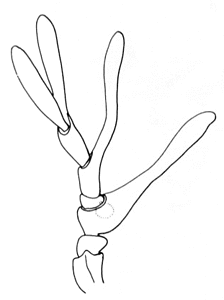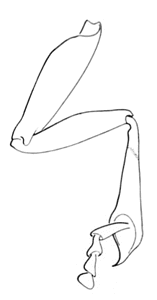Bohartillidae
Bohartilla
Jeyaraney Kathirithamby- Bohartilla megalognatha
- Bohartilla kinzelbachi

Introduction
So far only males are known from this family.
Kinzelbach (1969) described the first species in this new genus, Bohartilla megalognatha from Honduras. Kathirithamby & Grimaldi (1993) identified this genus in medium yellow Dominican amber: one male is morphologically indistinguishable from B. megalognatha, one male matches in several details the extant species and was named B. kinzelbachi. However, Pohl & Kinzelbach (1995) synonymised the B. megalognatha from the amber to B. joachimscheveni described by Kinzelbach & Pohl (1994) from Dominican amber. The only differences stated by Kinzelbach & Pohl (1994) of B. megalognatha from the amber from the extant B. megalognatha are: slender antennae, maxillae and longer legs; longer maxillary palpus. In other characters the amber specimen generally agrees with those of the extant species. Kinzelbach & Pohl also state that "as in most other specimens from the Dominican amber, there are almost no differences from living representatives at the species level". Kathirithamby & Grimaldi would like to reinstate B. megalognatha from the Dominican amber.
Another new species from the amber, B. kinzelbachi, was described by Kathirithamby & Grimaldi (1993), and the length of the basal maxillary segment of this specimen is 1.5x that of apical palpi.
Characteristics
The autapomorphic characters of this family are:
- Vth and VIth antennal segments are flabellate
- mandibles short and flat
- maxillary base long
- wings with MA1
Antennae are 7-segmented with the Vth segment broader than long and the IIIrd, Vth and VI segments have a flabellum. The mandibles are short and knife-shaped, and the maxillae have an extraordinarily long basal segment with a short palpus. Tarsi are 4-segmented without claws. The hind wing has a small cell MP, and CuA. The aedeagus is slightly curved.
The characteristics that distinguish Bohartillidae from the rest of the Stylopidia are the 7-segmented antennae (left), the long basal maxillary palpus (center), and the 4 tarsomeres (right). Drawings after Kinzelbach, from Kathirithamby (1989), copyright © 1989 Blackwell Science.
Distribution
- 2 males, La Ceiba, Honduras (1949) (day light) (Kinzelbach 1969) (Bohartilla megalognatha)
- 3 males, Dominican amber, Dominican Republic, (Bohartilla megalognatha, 1 male, Bohartilla kinzelbachi, 1 male Kathirithamby & Grimaldi 1993), and Bohartilla joachimscheveni, 1 male (Pohl & Kinzelbach 1995)
- 1 male, Ecuadore. Napo, Estatión Biológica Jatum Sacha (1989) blacklight trap (Kathirithamby ident. unpublished)
Host Relations
Only males of the extant species which have been found in traps are known, therefore the host relations are unknown.
References
Kathirithamby, J. 1989. Review of the order Strepsiptera. Systematic Entomology 14: 41-92.
Kathirithamby, J. and D. Grimaldi. 1993. Remarkable stasis in some Lower Tertiary parasitoids: descriptions, new records and review of Strepsiptera in the Oligo-Miocene amber of the Dominican Republic. Entomologica Scandinavica 24(1): 31-41.
Kinzelbach, R. 1969. Bohartillidae, eine neue Familie der Fächerflügler (Insecta, Strepsiptera). Beitiage neotrop Fauna 6: 92-101.
Kinzelbach, R. and H. Pohl. 1994. The fossil Strepsiptera (Insecta: Strepsiptera). Ann. Entomol. Soc. America 87(1):59-70.
Pohl, H. and R. Kinzelbach. 1995. Neufunde von Fächerflüglern aus dem Baltischen und Dominikanischen Bernstein (Strepsiptera: Bohartillidae & Myrmecolacidae). Mitt. Geol.-Paläont. Inst. Univ. Hamburg 78:197-209.
Title Illustrations

| Scientific Name | Bohartilla kinzelbachi |
|---|---|
| Comments | Specimen in Dominican amber; (a) ventral view of head, (b) dorsal view of body (venation on right wing omitted); (c) ventral view of abdomen. |
| Reference | Kathirithamby, J. and D. Grimaldi. 1993. Remarkable stasis in some Lower Tertiary parasitoids: descriptions, new records and review of Strepsiptera in the Oligo-Miocene amber of the Dominican Republic. Entomologica Scandinavica 24(1): 31-41. |
| Specimen Condition | Fossil |
| Sex | Male |
| Life Cycle Stage | adult |
| Body Part | head, abdomen |
| Type | Holotype |
| Copyright | © 1993 Entomology scandinavica |
About This Page
Jeyaraney Kathirithamby

University of Oxford, Oxford, UK
Correspondence regarding this page should be directed to Jeyaraney Kathirithamby at
Page copyright © 2005 Jeyaraney Kathirithamby
All Rights Reserved.
- First online 22 November 2004
Citing this page:
Kathirithamby, Jeyaraney. 2004. Bohartillidae. Bohartilla. Version 22 November 2004 (under construction). http://tolweb.org/Bohartilla/14513/2004.11.22 in The Tree of Life Web Project, http://tolweb.org/











 Go to quick links
Go to quick search
Go to navigation for this section of the ToL site
Go to detailed links for the ToL site
Go to quick links
Go to quick search
Go to navigation for this section of the ToL site
Go to detailed links for the ToL site